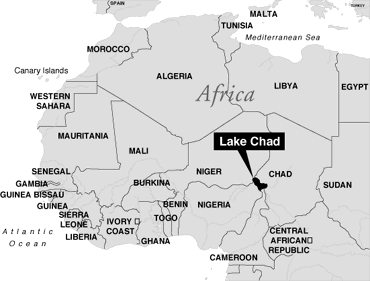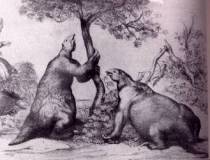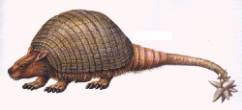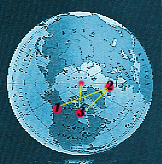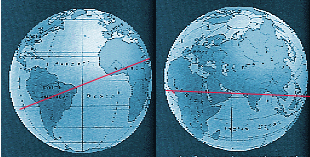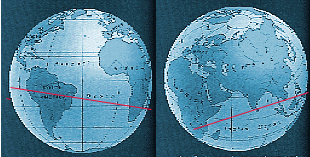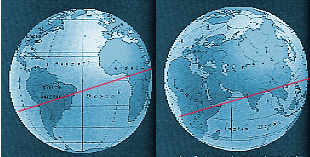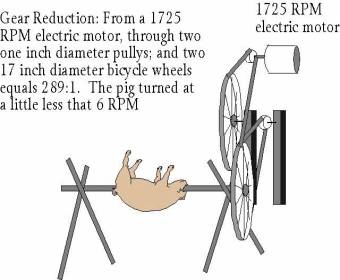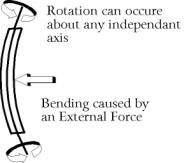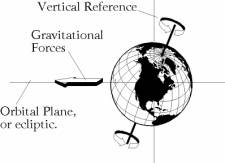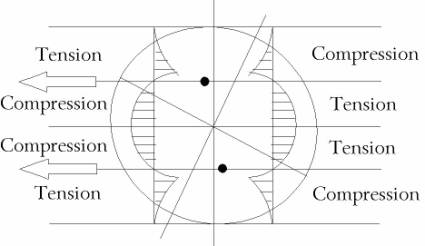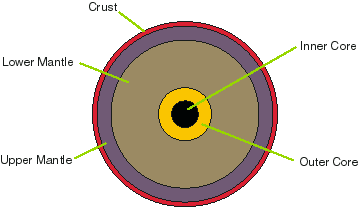Floods
The greatest flood to be accepted by orthodox science may be the deluge of 14,000 years ago [†] in the Altai Mountains of southern Siberia.
“It was an event that’s very hard to describe- because nothing comparable has ever been seen by people,” says Victor Baker, a geologist at the University of Arizona. “It’s the largest flood we can document in the fossil record.” At its height, he says, the water may have been 1,500 feet deep, racing along the Chuja River valley at 90 miles an hour.
Baker had been working with Alexey Rudoy, a Siberian geologist, who had argued for years that only massive flooding could have formed the oddly rippled terrain and giant bars of gravel found in the Chuja Valley and nearby regions – not glaciers, as was commonly believed.
“Near the end of the last ice age, they say, a glacier crawled out of a valley perpendicular to the Chuja Valley and cut across the latter, effectively damming it and creating a lake nearly 3,000 feet deep that held 200 cubic miles of water. Eventually that ice dam broke the
lake either burst through the dam or lifted the entire glacier. Water rushed into the narrow river valley at the rate of 640 million cubic feet per second, in a deluge that probably lasted several days.”The Chuja Valley flood was just the largest of numerous ice-age inundations, says Baker. “Even the English Channel has been attributed by some to late-glacial catastrophic flood erosion,” he says, “though it hasn’t been proven.”[34]
Meanwhile in North America:
The Missoula Floods, 16,000-14,000 years ago (Pleistocene)
Did you know that the largest floods to occur on the planet happened here? During the last ice age, ice sheets covered much of Canada. One lobe of ice grew southward, blocking the Clark Fork Valley in Idaho. This 2,000 foot (600 meters) high ice dam blocked the river, creating a lake that stretched for hundreds of miles. When the lake was full, it contained 600 cubic miles (2,500 cubic kilometers) of water. How much is that? Imagine a block of water a mile high (as high as the mountains around Bonneville Dam), a miles wide, and stretching from Bonneville Dam to San Francisco!
Eventually, water traveled under the ice dam. The water drained out of the lake in two or three days, flooding eastern Washington. The flood, moving up to sixty miles per hour, scoured out hundreds of miles of canyons called coulees, created the largest waterfall to ever exist, and left 300 foot (90 meter) high gravel bars. At Bonneville, the water crested at 650 feet (200 meters). If you look on the cliffs southeast of the dam, you will see a transmission tower (the one with three poles) that is 200 feet (60 meters) above the high water mark.
During a period of 2,500 years as many as 100 of these floods scoured the Gorge.
The source of this information is from a page at a U.S. Government website. It details the (orthodox) geologic history of the Columbia River Gorge. Like the Siberian flood, scientists describe a glacier that blocks a valley and creates a dam. However the trapped water does not freeze, it slowly builds up then bursts through the barrier of ice. This is apparently the only non-catastrophic, gradual situation they can think of!
Prior to the catastrophic floods, albeit 12-40 million years prior, this district was also host to a spectacular amount of volcanic activity. They state that 41,000 cubic miles (170,000 cubic kilometres) of lava spread to cover large parts of Oregon and Washington. This is enough to cover the entire continental USA with at least 12 metres of lava!! Elsewhere [35], sections of lava in the Columbia River area have been estimated to be 3,500 metres thick!!
If we were to disregard the dating of these events, then we have two obvious after-effects of a pole shift, one occurring directly on top of the other.
Volcanoes
An event as catastrophic as a pole shift would undoubtedly create an increase in volcanic activity. In fact, I suspect that every volcano along the “line of most movement” would have exploded. Evidence of past lava flows indicate that our current level of volcanic activity is very low, a mere whimper. In my opinion, there has been a gradual decline of activity over the last 10,000 years, as the earth’s crust has settled into its new position, and the volcanoes have slowly died down.
A shift of the crust would require some stretching and contracting due to the equatorial bulge. Any section of the crust that moved into the area of the equator would have to stretch to accommodate the bulge. On the other side of the equator, where section of the crust were moving away, there would be contraction. Distortions of this magnitude would give us the “fire” element so often part of the flood myths – volcanoes.
“In Arizona, New Mexico and southern California there are very fresh looking volcanic formations. The lava flow in the valley of the San Jose River in New Mexico is so fresh that it lends support to Indian traditions of a “river of fire” in this locality.”[36]
Ten thousand years ago, volcanoes were active everywhere. Listed here are the active
areas of the southern hemisphere:[37]
| Nigeria
Kenya Tanzania Great Rift Valley Madagascar Indian Burma |
Malaysia
Indonesia New Hebrides Bismarck New Guinea New Solander Islands |
Australia:
SE NSW
Tasmania |
Antarctica:
Ellsworth Land Marie Byrd Land The Andes (entire) Brazil – Mato Grasso Chile (800 volcanoes) |
The northern hemisphere covers pretty much everywhere except Europe.
As we can see, Chile alone had more active volcanoes back then, than the 500 the entire globe has today. Volcanoes are so sensitive that we can assume the majority of them would erupt during a pole shift situation. Our atmosphere would be filled with dust and the sun would effectively disappear from view for a few years. An example of this is the eruption of Krakatoa in 1883 – this single volcano lowered the mean earth temperature by about 1ºC for several years[38], and many parts of the world lost an entire growing season. With hundreds of volcanoes erupting at once our planet would be plunged into winter, with the new poles freezing over rapidly.
The amount of dust in the air, and corresponding lack of sunlight caused by a pole shift is unpredictable, but even a layman can guess that it would be many, many times more severe than the explosion of Krakatoa. A number of doomsday researchers have pointed out how the dust would create a tragic, incredibly cold period. However, the severity may well be offset in part by the carbon dioxide that volcanoes produce. While dust will stop the sun’s rays from entering our atmosphere, carbon–dioxide will stop heat from escaping, the much discussed “greenhouse effect”. Carbon dioxide also stimulates plant growth, but only when there is sunlight as well. The climate following a pole shift is very difficult to predict. Prepare for anything.
| Volcanic Gases. All magmas contain dissolved gases that are released during and between eruptive episodes. These gases are predominately steam, followed in abundance by carbon dioxide, compounds of sulfur and chlorine, and lesser amounts of other gases. While they rarely reach populated areas in lethal concentrations, sulfur dioxide can travel downwind and react with the atmosphere to form acid rain that causes corrosion and a host of other problems. Carbon dioxide is heavier than air and tends to collect in depressions, such as valleys, where it can occur in concentrations lethal enough to cause suffocation of people and animals.[39] |
Seashells
In my own travels, during a visit to mountains in New Zealand, I pondered over why there should be seashells high upon them. Yes, New Zealand is a relatively new country – supposedly it slowly rose from the ocean 26 million years ago. But how are these shells, which easily break beneath my shoes, which I could easily turn into sand, still in one piece after 26 millions of years? Have they survived earthquakes and weather for such a terribly long time? Or could the islands of New Zealand have re-emerged from the ocean only 12,000 years ago?[40]
Graham Hancock found a similar situation at Lake Titicaca, on the border of Peru and Bolivia:
Though now more than two miles above sea level, the area around Lake Titicaca is littered with millions upon millions of fossilized sea shells. This suggests that at some stage the whole of the Altiplano was forced upwards from the sea-bed, perhaps as part of the general terrestrial rising that formed South America as a whole…[41]
This would be in line with orthodox scientists, who believe that this occurred very slowly
100 million years ago. But Hancock points out that many of the fish and crustacea in the lake are of a salt-water variety, as if they hadn’t had time to evolve into fresh water types. Indeed this is the only fresh water location on earth where seahorses live.
The ancient city of Tiahuanaco, is currently 12 miles distant, and 100 feet higher than the lake. Yet, this city has ruined docks, which implies that within the civilised history this area was subject to a major upheaval. It is frightening to think that there are forces that can shift landscapes two miles vertically, and this may have happened 12,000 years ago in South America.
+++++
You may have noticed that we haven’t discussed any internal forces that can make the poles shift – I don’t think there are any. The RB-Effect of James Bowles relies on the pull of the sun and the moon. I believe the required forces must come from farther away.
Extra-terrestrial forces are infinite and mostly unknown. If something out there is capable of tilting the Earth, we are yet to discover it. But there are a few clues. Global cataclysms have occurred previously, and presumably will happen again. Any prediction of when must be based on calculable processes. If the Mayan calendar proves to be prophetic, then this cosmic disturbance must be a regular and predictable occurrence, not a random collision or interaction. If evolution is caused by cosmic rays (see
Chapter XX), then they must be a component of the disturbance. And if humanity manages to survive each cataclysm, the disturbance’s effect must fall a little short of total annihilation.
And so ends the chapter on poleshifts.
Related Links
On the Possibility of Very Rapid Shifts of the Poles,
by Flavio Barbiero – Technical
[†] Remember, in this book, we are assuming that carbon-dating prior to the last pole shift will be inaccurate.
[34] Folger, Tim; The Biggest Flood, Discover, 15:36, January 1994.
[35] Volcano World, (sponsored by NASA) http://volcano.und.nodak.edu/vwdocs/volc_north_america/crb.html
[36] Jaggar, Thomas A., Volcanoes Declare War. Honolulu, Paradise of the Pacific, (1945), page 113
[37] D. S. Allan & J. B. Delair, When the Earth Nearly Died (1995), p261
[38] Rampino, M. R. and S. Self. Historic eruptions of Tambora (1815), Krakatau (1883), and Agung (1963), their stratospheric aerosols, and climatic impact. Quaternary Research 18:127-143. (1982)
[39] http://wapi.isu.edu/EnvGeo/EG6_volcano/volcanoes.htm
[40] At 1,400 feet (400 meters) altitude in the Andes Mountains of South America, there are high water surf marks lined
with undecayed seashells.
[41] Graham Hancock, Fingerprints of the Gods, 1995, page 67


